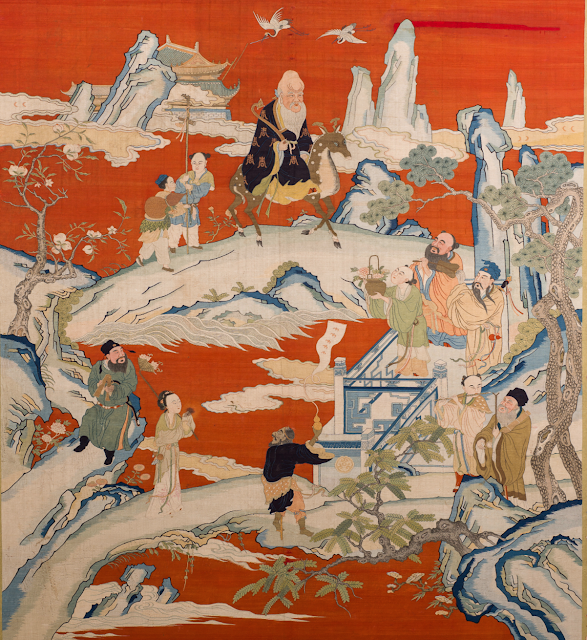Wishing for Good Luck, Longevity and a Blessed Life
"Hope for longevity and a blessed life became an ultimate goal for Koreans since the late Choson dynasty, when society became stabilized and the quality of life improved." Yeol-su Yoon pg. 15
I looked up the Choson Dynasty for dates and brief background as my understanding of Korean History is rudimentary at best.
Again my Korean history is something I'm working out in tandem with art and culture but seems like 1910 Korea was under Japanese rule? So again I Googled and found this:Between 1910 and 1945 the Empire of Japan placed Korea under Japanese rule or Japanese Occupation. Joseon Korea had come into the Japanese sphere of influence with the Japan–Korea Treaty of 1876, and a complex coalition of the Meiji government, military, and business officials[6] began a process of integrating the Korean peninsula's politics and economy with Japan. The Korean Empire (proclaimed in 1897) became a protectorate of Japan with the Japan–Korea Treaty of 1905; thereafter Japan ruled the country indirectly through the Japanese Resident-General of Korea. Japan formally annexed Korea in 1910 in the Japan–Korea Treaty of 1910,[7] without the consent of the former Korean Emperor Gojong, the regent of the Emperor Sunjong.[8][9][10] The Japanese Empire had established the Korean peninsula as a colony of Japan administered by the Governor-General of Chosen based in Keijō (Gyeongseong) which governed Korea with near-absolute power. https://en.wikipedia.org/wiki/Korea_under_Japanese_rule
So reading the above I am a little confused. Sounds like Korea was its own State in the 1800's but was becoming a part of the Japanese Empire, and I am not sure if the author of "Handbook of Korean Art, Folk Painting" means that during the Choson dynasty (which spans a little more than 500 years) this idea of longevity and a blessed life became important, but that is what I am going to guess. That this is during this time period.
Images depicting the wish for longevity and good luck which is also translated as "happiness" throughout the text, may include the sun, clouds, pine trees, bamboo, cranes, deer, turtles, water, rocks and lingzhi or immortals' fungus. Lingzhi is also know as reishi: https://en.wikipedia.org/wiki/Lingzhi_(mushroom)
The Jordan Snitzer Museum of Art, University of Oregon has more information here: https://jsma.uoregon.edu/exhibitions/ten-symbols-longevity-and-late-joseon-korean-culture
It is hard to see in my little screen shot but if you visit the University of Oregon's site you can see that Yeol-su Yoon's list of symbols are well represented: the sun, clouds, pine trees, bamboo, cranes, deer, water, rocks, and lingzhi are all here. I cannot see if turtles are depicted, that would be the only one missing from Yoon's list.Also in the Jordan Snitzer Museum of Art is a Chinese Tapestry: Hanging with God of Longevity (Shoulao) in Auspicious Landscape Design
The Detroit Institute for the Arts offers another longevity screen, this one is embroidered. And in the description gives reasoning behind the symbols:
https://www.dia.org/art/collection/object/embroidered-screen-design-longevity-symbols-51204
From the description "Longevity is held in high esteem and is one of the most frequent and popular subjects in Korean art. Enduring eternally and sustaining life, the sun, clouds, water, and mountains are the background for other symbols of long life in a landscape paradise. The pine and bamboo, noted for their hardiness and resiliency, are often compared to venerable old men. Various legends associate cranes, tortoises, and deer with happiness, good luck, and long life. Deer are said to be the only creatures able to find the sacred fungus, a supernatural mushroom of immortality."
The image at the top of this post was taken from : https://artsandculture.google.com/asset/painting-of-ten-longevity-symbols-on-ten-panel-folding-screen/zgFhp2rcoNz6lg
The rights to this screen are owned by the National Palace Museum of Korea. The description says that the 10 longevity symbols originate from Chinese Taoism.








Comments
Post a Comment